11 Best Herbal Creams For Oily Face
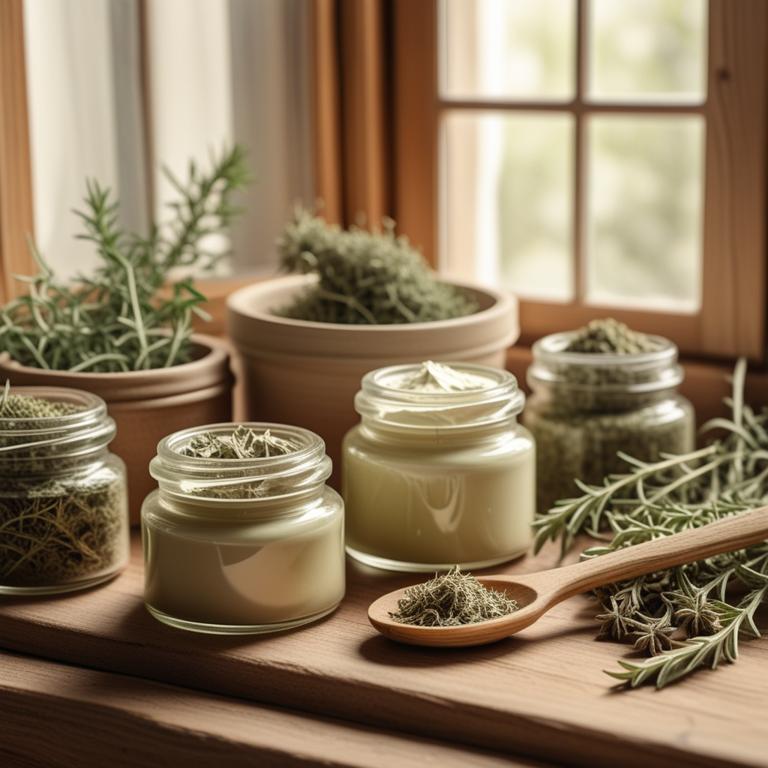
Herbal creams for oily face are topical treatments that contain natural plant extracts, designed to help regulate sebum production and reduce excess oil on the skin.
These creams offer numerous benefits, including a reduction in acne, prevention of clogged pores, and improvement in skin texture and tone.
Examples of herbal creams used to treat oily face include tea tree oil, aloe vera, and chamomile, due to their anti-inflammatory and antibacterial properties that help soothe and calm the skin, while also controlling oil production.
Other examples include lavender, green tea, and rosehip, which are rich in antioxidants and help to balance the skin's natural pH and reduce oiliness.
N/A
Below there's a list of the 11 best herbal creams for oily face.
- 1. Aloe barbadensis creams
- 2. Melaleuca alternifolia creams
- 3. Lavandula angustifolia creams
- 4. Calendula officinalis creams
- 5. Rosmarinus officinalis creams
- 6. Thymus vulgaris creams
- 7. Camellia sinensis creams
- 8. Mentha x piperita creams
- 9. Salvia officinalis creams
- 10. Hypericum perforatum creams
- 11. Avena sativa creams
Also you may be interested in...
TODAY'S FREE BOUNDLE
Herb Drying Checklist + Herbal Tea Shopping List + Medicinal Herbs Flashcards
Enter you best email address below to receive this bundle (3 product valued $19.95) for FREE + exclusive access to The Aphotecary Letter.
$19.95 -> $0.00
1. Aloe barbadensis creams

Aloe barbadensis creams have been widely used to treat oily face ailments due to their soothing and calming properties, which help to balance the skin's natural pH and reduce excess oil production.
The anti-inflammatory and antibacterial properties of Aloe barbadensis creams also help to reduce acne and prevent the formation of blackheads, thereby controlling the oily face condition.
The bioactive constituents of Aloe barbadensis creams, such as aloin and aloe-emodin, possess astringent properties that help to tighten the skin and reduce sebum production, thereby treating oily face ailments.
Regular use of Aloe barbadensis creams can provide several benefits, including improved skin texture, reduced pores, and a more even skin tone, making it an effective and natural remedy for oily face ailments.
Related Study
According to "Adverse drug reactions and toxicological reviews", Aloe barbadensis creams for oily face may be beneficial due to its wound healing properties and other beneficial effects on skin, despite limited information on its efficacy in controlled clinical trials for oily face specifically.
2. Melaleuca alternifolia creams

Melaleuca alternifolia creams, derived from the leaves of the tea tree, have been found to be effective in treating oily face ailments.
The anti-inflammatory and antiseptic properties of this herbal preparation help to reduce inflammation and prevent the growth of bacteria that can cause acne.
The bioactive constituents, including cineole and terpinen-4-ol, present in Melaleuca alternifolia creams, have been shown to exhibit antimicrobial and antifungal properties, which aid in controlling oil production and preventing clogged pores.
The benefits of using Melaleuca alternifolia creams to treat oily face ailments include reduced acne severity, improved skin clarity, and a balanced skin pH, leading to a healthier and more radiant complexion.
3. Lavandula angustifolia creams

Lavandula angustifolia creams have been traditionally used to treat oily face ailments due to their astringent and antiseptic properties, which help to reduce the oil production and prevent bacterial growth on the skin.
The antiseptic properties of Lavandula angustifolia creams, particularly linalool and linalyl acetate, help to treat oily face ailments by reducing inflammation and preventing the spread of infection.
The bioactive constituents of Lavandula angustifolia creams, including flavonoids and terpenoids, help to regulate the sebum production and improve the overall skin health, thereby treating oily face ailments effectively.
The benefits of using Lavandula angustifolia creams to treat oily face ailments include reduced oil production, improved skin texture, and a more balanced and healthy complexion.
4. Calendula officinalis creams

Calendula officinalis creams have become a popular natural remedy for treating oily skin and facial issues due to their anti-inflammatory, antimicrobial, and antioxidant properties.
These properties help to reduce redness and inflammation, combat bacterial and fungal infections, and protect the skin from environmental stressors, thereby treating the oily face ailment effectively.
The bioactive constituents of Calendula officinalis, such as triterpenoids and flavonoids, play a crucial role in its therapeutic effects, including its ability to regulate skin cell growth and improve skin texture.
The benefits of using Calendula officinalis creams for oily skin include a reduction in sebum production, a decrease in acne and other skin irritations, and an overall improvement in skin health and appearance.
5. Rosmarinus officinalis creams
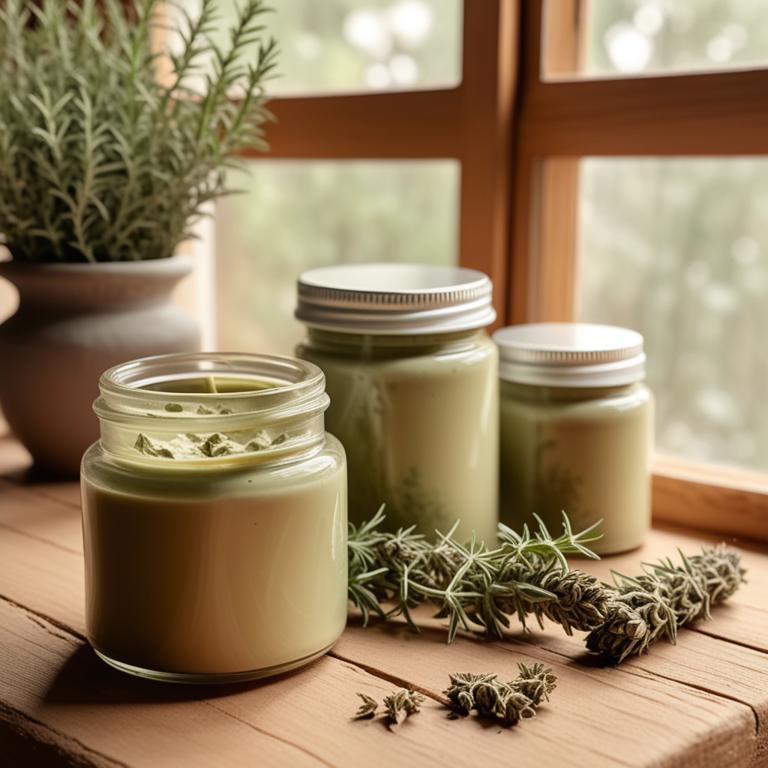
Rosmarinus officinalis creams are a natural and effective treatment for oily face ailments, thanks to their antiseptic, astringent, and anti-inflammatory properties.
These herbal preparations help to treat oily skin by controlling sebum production, reducing acne and inflammation, and balancing the skin's pH levels.
The bioactive constituents of Rosmarinus officinalis, such as camphor, bornyl acetate, and beta-pinene, play a crucial role in its therapeutic effects, acting as a natural astringent and antiseptic to control oil production and reduce bacterial growth.
The benefits of using Rosmarinus officinalis creams to treat oily face ailments include reduced inflammation, improved skin texture, and a more balanced and healthy complexion.
6. Thymus vulgaris creams
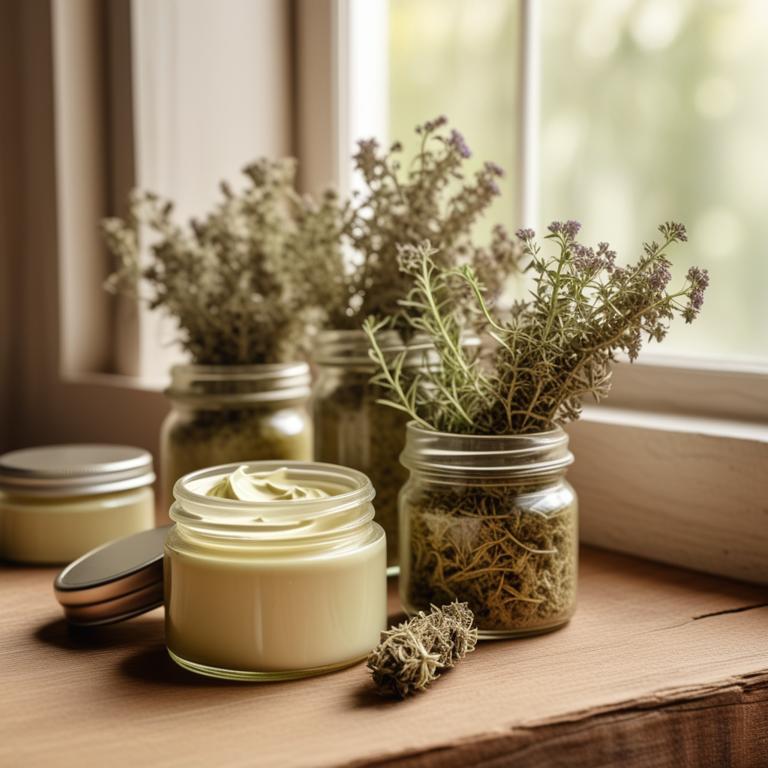
Thymus vulgaris creams have been used for centuries to treat oily face ailments due to their antibacterial, anti-inflammatory, and astringent properties.
The bioactive constituents, such as thymol and carvacrol, in these creams help to balance the skin's natural pH, reduce sebum production, and prevent bacterial growth, thereby treating oily skin.
These herbal preparations work by tightening the pores, reducing oiliness, and promoting a healthy skin balance, ultimately alleviating symptoms of oily skin.
The benefits of using Thymus vulgaris creams include a reduction in acne, minimized pores, and a more even skin tone, making them a popular natural remedy for treating oily face ailments.
7. Camellia sinensis creams
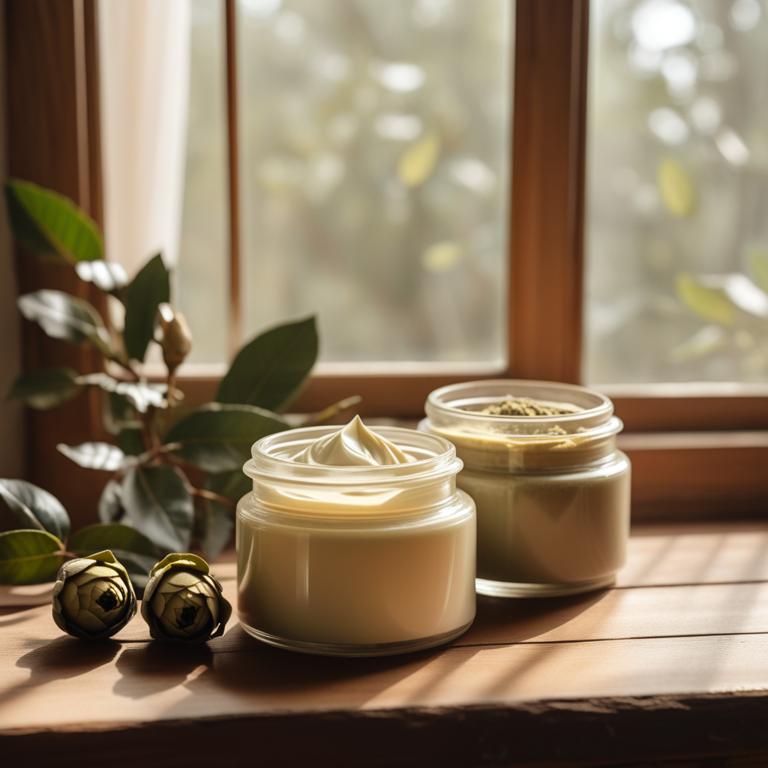
Camellia sinensis creams have been gaining popularity as a natural remedy to treat oily face ailments due to their ability to balance the skin's pH and reduce excess oil production.
The properties of Camellia sinensis creams, including their anti-inflammatory and antioxidant properties, help to soothe and calm the skin, reducing the appearance of pores and leaving the skin looking smoother and more even-toned.
The bioactive constituents present in Camellia sinensis creams, such as theaflavins and thearubigins, help to regulate sebum production and prevent clogged pores, resulting in a more balanced and healthy-looking complexion.
Regular use of Camellia sinensis creams can provide long-lasting benefits, including a reduction in oiliness, improved skin texture, and a more radiant and youthful appearance.
8. Mentha x piperita creams

Mentha x piperita creams are a popular herbal preparation used to treat oily face ailments due to their astringent and antiseptic properties, which help to balance the skin's pH and reduce excess oil production.
This herbal preparation helps to treat oily face by reducing inflammation, preventing acne formation, and promoting a healthy skin environment, ultimately leading to a clearer and more balanced complexion.
The bioactive constituents of Mentha x piperita creams, including menthone, menthol, and limonene, exhibit antioxidant and anti-inflammatory activities that contribute to its therapeutic benefits.
The benefits of using Mentha x piperita creams to treat oily face include reduced oil production, prevention of acne and other skin issues, and a smoother and more even-toned skin, making it an effective and natural remedy for individuals suffering from oily skin.
9. Salvia officinalis creams
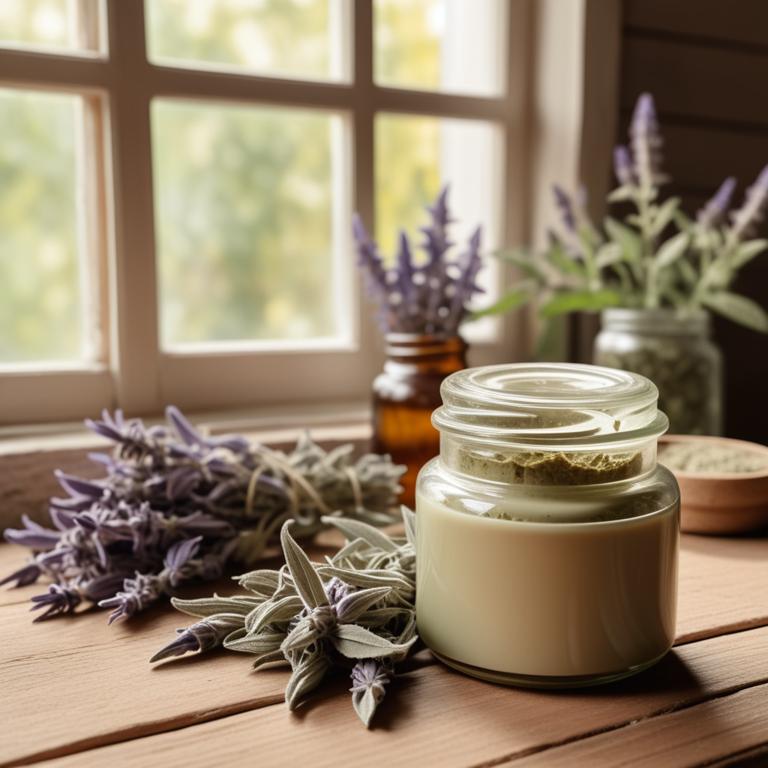
Salvia officinalis creams, derived from the leaves of the sage plant, are a popular herbal preparation to treat oily face ailments.
The antiseptic and anti-inflammatory properties of Salvia officinalis creams help to reduce the production of sebum and soothe irritated skin, thereby addressing the root causes of oily skin.
The bioactive constituents, including rosmarinic acid and camphor, in Salvia officinalis creams have astringent and antiseptic effects that help to control oil production and prevent bacterial growth on the skin.
By using Salvia officinalis creams, individuals can benefit from reduced oiliness, improved skin clarity, and a more balanced skin pH, ultimately achieving a healthier and more radiant complexion.
10. Hypericum perforatum creams

Hypericum perforatum creams, derived from the St. John's Wort plant, have been traditionally used to treat oily face ailments due to their astringent, antiseptic, and anti-inflammatory properties.
The bioactive constituents, such as hyperforin and hypericin, help to regulate sebum production, reduce inflammation, and prevent the growth of bacteria that can cause acne.
By applying these creams to the affected area, the skin's natural balance is restored, reducing the appearance of oily skin and preventing further breakouts.
The benefits of using Hypericum perforatum creams include a decrease in sebum production, reduced redness and inflammation, and improved overall skin health, making it a popular natural remedy for oily skin issues.
11. Avena sativa creams
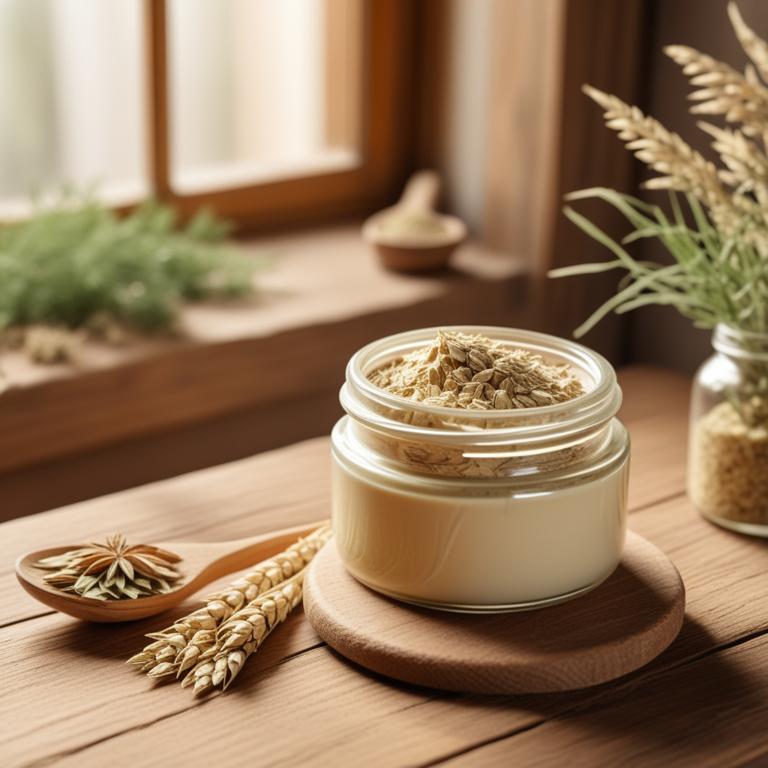
Avena sativa creams are a popular herbal preparation used to treat the oily face ailment, characterized by excessive sebum production and clogged pores.
The properties of Avena sativa, including its anti-inflammatory and antioxidant effects, help to reduce inflammation and combat free radicals that contribute to skin congestion.
The bioactive constituents of Avena sativa, such as avenanthramides and ferulic acid, have been shown to inhibit 5-alpha-reductase, an enzyme responsible for converting testosterone to dihydrotestosterone, a hormone that stimulates oil production in the skin.
The benefits of using Avena sativa creams to treat oily skin include reduced sebum production, improved skin elasticity, and a more balanced skin pH, resulting in a healthier and more radiant complexion.